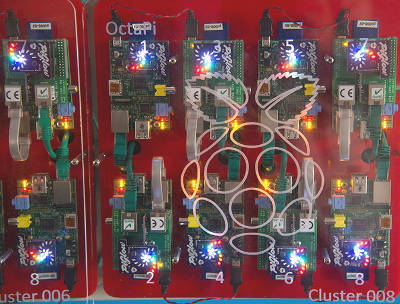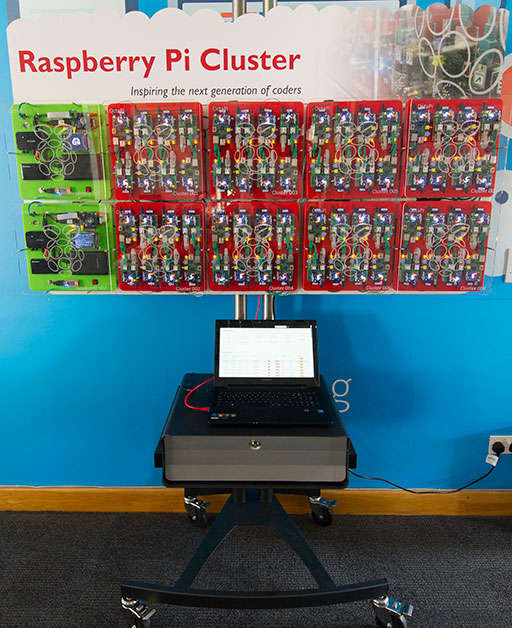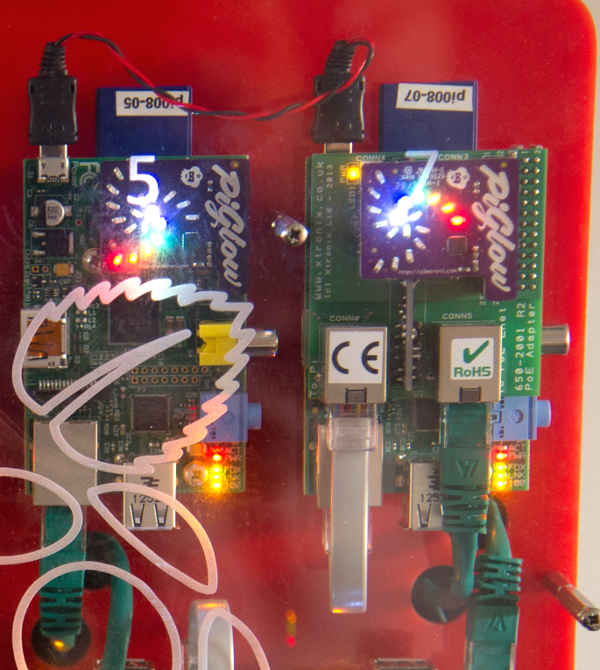| GCHQ Builds A Raspberry Pi Cluster |
| Written by Harry Fairhead | |||
| Sunday, 15 March 2015 | |||
|
GCHQ, the UK equivalent of the NSA, has created a 66 Raspberry Pi cluster called the Bramble for "educational" purposes. What educational purposes isn't exactly clear, but you do associate super computers with spooks and spies. This isn't an official GCHQ project so I doubt it has been built to monitor phone networks or crack codes. It seems that there was an internal competition to invent something and three, unnamed, GCHQ technologists decided that other Pi clusters were too ad-hoc. They set themselves the target of creating a cluster that could be reproduced as a standard architecture to create a commodity cluster. The basic unit of the cluster is a set of eight networked Pis, called an "OctaPi" - one thing you have to admit is that the Raspberry Pi name lends itself to silly variations. The size of the OctaPi was dictated by the need to make the unit reasonable from the point of view of size, power consumption, cooling and so on. The Pis are driven by power over ethernet (PoE) to reduce the wiring and each one has an LED display.
Each OctaPi can be used standalone or hooked up to make a bigger cluster. In the case of the Bramble a total of eight OctaPis makes the cluster 64 processors strong. In addition there are two head control nodes, which couple the cluster to the outside world. Each head node has one Pi, a wired and WiFi connection, realtime clock, a touch screen and a camera. The fact that the head units have a video camera does mean that you could use the cluster to do real time video processing and machine vision, but of course this all depends on the software that it runs. All of the Pis are model Bs, but changing to a B2 would make the cluster a lot more powerful and no more expensive to build. This is where the story becomes really interesting. Rather than just adopt a standard cluster application like Hadoop, OctaPi's creators decided to develop their own. After three iterations, the software to manage the cluster is now based on Node.js, Bootstrap and Angular.
So what is it all for? The Bramble was unveiled at the recent Big Bang Fair held in Birmingham, UK, which was aimed at getting children interested in science and engineering. The press release says that: "The initial aim for the cluster was as a teaching tool for GCHQ’s software engineering community." and then goes on to say: "The ultimate aim is to use the OctaPi concept in schools to help teach efficient and effective programming. Watch this space for more details!" I'm not at all sure that schools really need the complexities of a cluster to teach efficient and effective programming - this is more of interest at the next level up. Sadly there is no information on how to make the Bramble or about its software. Given the idea was to create something that others could build, this isn't what you would expect. Is it going to be open source? Given that this is a GCHQ creation it seems unlikely, but we can hope.
More InformationGCHQ's Raspberry Pi 'Bramble' - exploring the future of computing Related ArticlesFive Million - That's A Lot Of Raspberry Pi Raspberry Pi 2 - Quad Core And Runs Windows Astro Pi - What Can A Raspberry Pi Do In Space? Is This What It Now Means To Build A Computer? Buy A Pi For $25 And Get Mathematica Free Raspberry Pi To Star In Class? Raspberry Pi Gets A $25 Camera Raspberry Pi Photo Competition Results Are Stunning To be informed about new articles on I Programmer, install the I Programmer Toolbar, subscribe to the RSS feed, follow us on, Twitter, Facebook, Google+ or Linkedin, or sign up for our weekly newsletter.
Comments
or email your comment to: comments@i-programmer.info |
|||
| Last Updated ( Sunday, 15 March 2015 ) |




